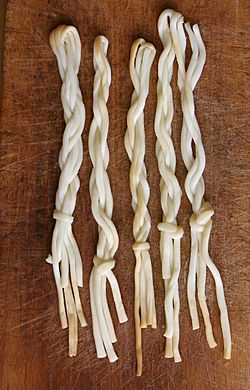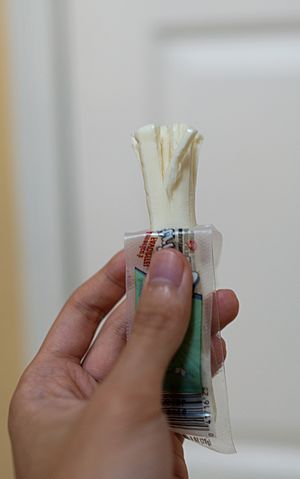String cheese facts for kids

|
String cheese refers to several different types of cheese where the manufacturing process aligns the proteins in the cheese, which makes it stringy.
When mozzarella is heated to 60 °C (140 °F) and then stretched, the milk proteins line up. It is possible to peel strings or strips from the larger cheese.
Contents
Central Europe
In Slovakia, korbáčiky is made, which is a salty sheep milk cheese, available smoked or unsmoked. It is traditionally made by hand-pulling steamed sheep's cheese into strings and braiding them. Cow milk versions are also available.
Eastern Europe/West Asia
In Turkey, the most common type of string cheese is dil peyniri ("tongue cheese"), a fresh white cheese made from cow's milk, traditionally in the provinces of Bilecik and Bursa. The stringy texture of dil becomes even more prominent when the cheese is melted.
In Armenia, traditional string cheese, chechil, is made with a white base. The type of milk used usually comes from an aged goat or sheep depending upon the production methods of the area of choice. It is seasoned with black cumin and mahleb, and is traditionally sold in the form of a braided endless loop. The cheese forms into strings due to how it is pulled during processing. It is also made in Syria and Turkey, both countries with significant Armenian populations.
In Georgia and Russia string cheese is known as tenili (ტენილი ყველი [ka], Тенили [ru]). It is made from fermented sheep's milk and cream allowed to mature for 60 days in a salted and dried veal stomach.
Western Europe
Cheestrings became a popular snack in the UK and Republic of Ireland soon after their introduction in 1996. They are made from real cheese, not processed cheese, by Kerry Group and the mascot is a cartoon character called Mr Strings.
The original advert had a theme tune based on the popular song "Bend Me, Shape Me", but with different lyrics ("You got a cheese string day or night, you got a cheese string you're all right"). The first version of this advert was set at a kids' disco, and a later remake was set at a funfair. Originally Mr Strings was a wild cartoon character who pulled himself apart but by the late 1990s the packaging had been redesigned with a more simplified mascot. On television the original Mr Strings was phased out during the mid 2000s and replaced by an unseen character who played creepy practical jokes on teenage consumers. In the late 2000s the design of Mr Strings was changed for a third time to appear more child-friendly and was given a new catchphrase ("Hey, I'm just cheese").
Cheestrings are currently available in Original (a cheese akin to mozzarella) and the two-colour Twisted variety. Discontinued flavours include cheddar, smoky bacon, and pizza, with the pizza flavour being reintroduced in May 2021 to celebrate the 25th anniversary of Cheestrings.
Kerry exports Gouda Cheestrings from Charleville, County Cork to Holland, and a Gouda-Emmental mix to France, where the product is known as Ficello. Low cost imitations of the original cheddar Cheestrings were formerly manufactured in the UK by Tesco, Dairylea, and currently by Dunnes Stores. An item in the product range of the original Kerry Cheestrings, known as Attack-A-Snack (a rival to Dairylea Lunchables), packaged with a tortilla wrap or cracker, sachet of tomato ketchup, and piece of processed ham has been available from the late 90s.
North America
Mexico
In Mexico, the first type of string cheese was invented in 1885 by Leobarda Castellanos García at 14 years old. A very popular type of string cheese called Quesillo is sold today in balls of various sizes. It is also known as "Queso Oaxaca" or Oaxaca cheese referred to the place of origin it was invented, and now it's widely popular in all Mexican territories.
United States
In the United States, string cheese generally refers to snack-sized servings of low-moisture mozzarella. This form of string cheese is roughly cylindrical, about 6 inches (15 cm) long and less than 1 inch (2.54 cm) in diameter. The common term is a "cheese stick" which is cut and packaged, either individually or as a package of several lengths.
The cheese used is nearly always a form of mozzarella, or a combination of mozzarella and cheddar. This type of string cheese gets its name because it can be eaten by pulling strips of cheese from the cylinder along its length and eating these strings. It was invented in 1976 by Frank Baker.
Oceania
In Australia, string cheese is sold by Bega Cheese and is called Bega Stringers. String cheese can also be sold in a can. In the Marquesas Islands, a popular variety of string cheese is made from breadfruit proteins and buffalo milk, and is marketed under the brand Sea King String.


